<center>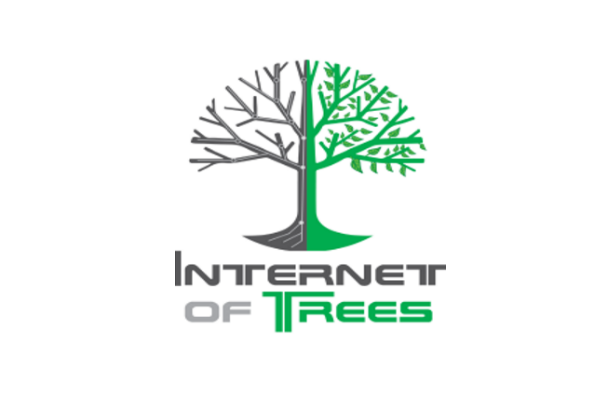</center>
<center>([source](https://www.startupbootcamp.org/startups/internet-of-trees/))</center>
In this post I’d like to start discussion of the systems which could help us to prevent such destructive events like you can see in the video below.
https://www.youtube.com/watch?v=qi6dAPBvyYU
According to [CTIF](www.ctif.org) **Center of Fire Statistics** report on **World Fire Statistics** № 24 (2019) (which can be downloaded at https://www.ctif.org/world-fire-statistics (CTIF_Report24_ERG.pdf file)) fires represent serious problem for humanity.
> CTIF develops comprehensive world fire statistics by publishing annual reports which offer data on fire issues from 80 different countries and 90 capital cities.
[source](https://www.ctif.org/node/1009)
The **number of human deaths** over a period of 1993-2017 averages to **over 42,000 per year** (based on the data obtained from 27-57 countries, which collectively represents 0.9-3.8 billion inhabitants of the Earth).
And the **number of fires** over that period of time averages to **over 3,7 millions per year** [[5](https://www.ctif.org/world-fire-statistics)].
I don’t want even imagine, how much animals were killed in all those fires.
<center>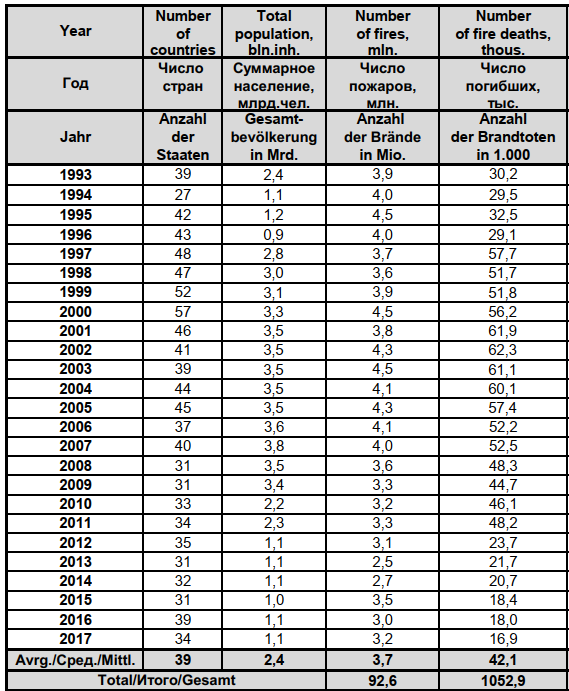</center>
<center>(source - CTIF_Report24_ERG.pdf file mentioned above)</center>
The table below shows the number of fire deaths, fire injuries, fires themselves and other parameters by country based on statistics data of 2017.
<center>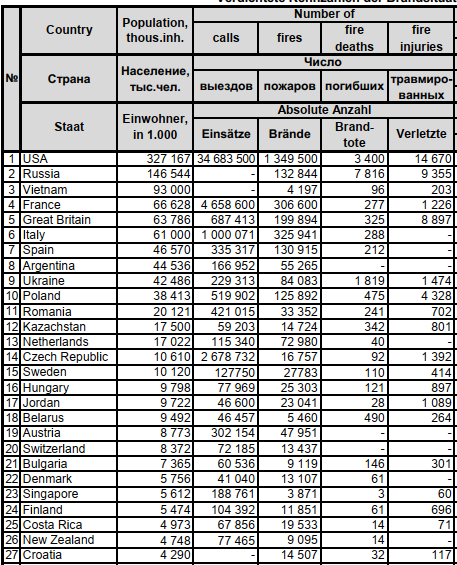</center>
<center>(source - CTIF_Report24_ERG.pdf file mentioned above)</center>
You can see that for example in Russia there were 132, 844 fires, 7, 816 deaths and 7, 816 injuries caused by fires in 2017 [[5]](https://www.ctif.org/world-fire-statistics).
According to information provided by one of the team members of [Internet of Trees](http://internetoftrees.tech/) startup
> Around 340 million hectares of forest suffer from a fire every year. That’s more than 10 percent of the world’s forests. If they are not controlled, they can spread twice as fast as a walking pedestrian.
[source](https://electronics360.globalspec.com/article/11399/internet-of-trees-early-detection-of-forest-fires)
**Typical causes**
* dry weather
* high temperatures
* thunder strikes
* the magnifying glass effect [[6](https://medium.com/@internetoftrees/latest-forest-fires-in-california-highlight-need-for-better-and-earlier-detection-systems-93ba0caf2303)]
> (a piece of broken glass that focuses sunlight heat on a particular point of forest) (source)
* electrical fire
* human carelessness
If you wonder what the deadliest fires in history are, then here’s some data from Wiki.
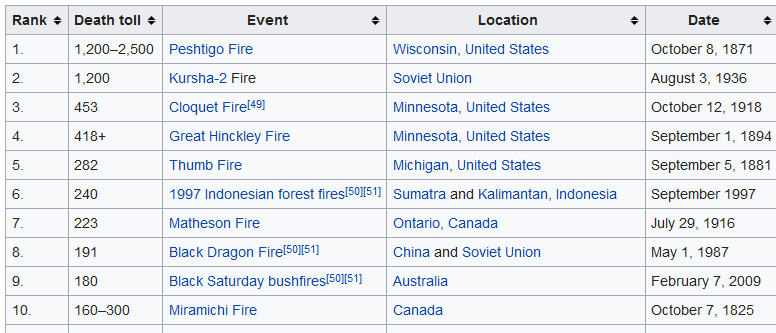
<center>[source](https://en.wikipedia.org/wiki/List_of_natural_disasters_by_death_toll#Deadliest_wildfires_/_bushfires)</center>
And below you can see the image of **Camp Fire**
> the deadliest and most destructive wildfire in California history
[source](https://en.wikipedia.org/wiki/Camp_Fire_(2018))
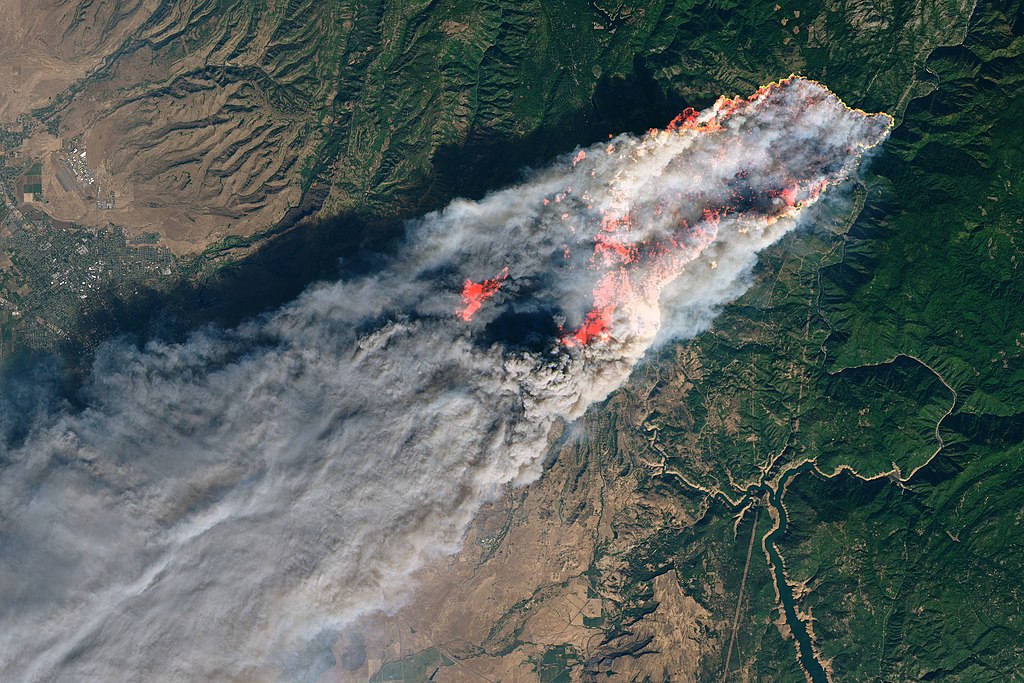
<center>([source](https://en.wikipedia.org/wiki/Camp_Fire_(2018)); Public domain)</center>
> It covered an area of 153,336 acres (62,053 ha) (almost 240 sq. miles), and destroyed 18,804 structures, with most of the damage occurring within the first four hours.
[source](https://en.wikipedia.org/wiki/Camp_Fire_(2018))
--> "...within the first four hours."
> A fire starting after 10 o’clock at night, under 50-plus mph winds, under absolutely dry, dry fuel beds, every one of those fires had a fighting chance to get going long before our firefighters could even be able to get there. So they all grew into major fires very quickly.” — CAL Fire Chief, Ken Pimlott.
[source](https://medium.com/@internetoftrees/latest-forest-fires-in-california-highlight-need-for-better-and-earlier-detection-systems-93ba0caf2303)
So, the problem is that people find out about fires too late.
That’s where **Internet of Trees** comes in. The idea is to allow people **be proactive** rather than reactive when it comes to fires.
Before discussing their early-warning solution I’d like to talk a little about [IoT (Internet of Things)](https://en.wikipedia.org/wiki/Internet_of_things).
For the uninitiated, Internet of things (IoT) refers to the connection of devices via Internet (Wi-Fi) which can exchange data between each other and people (who can control them).
For example, there’re smart refrigerators which can notify you about the state of the food and communicate with your smart dishwasher or microwave (For more information ->https://en.wikipedia.org/wiki/Smart_home_technology).
Heck, there’re even systems which allow you to be notified (via SMS) when your flower needs some water or monitor the state of the soil in your greenhouse.
And we have **Environmental Sensor Networks (ESNs)**. This is kind of IoT-applications for environmental needs.
They provide us sort of ‘virtual’ connection with the environment via a system of sensors which collect the data needed.
Ultimately they send the data to **a central server** where they can be collected, processed and analyzed by people [[1](https://www.semanticscholar.org/paper/Environmental-Sensor-Networks%3AA-revolution-in-the-Hart-Martinez/2c2a6ed5b7c792c8a53fd3fc7e437371fe8a0128)].
“Internet of Trees” is not only the name of the startup, but is also the name of the system of special sensors/modules (called Fire Rangers) which can help you to monitor in real-time (data is processed within milliseconds) temperature variations, smoke air humidity and detect fires.
The latter happens when Internet of Trees modules find unusual patterns of the microclimate in the forests.
Batteries of those modules can last out up to 3-5 years.
> Roughly, one module is needed per every hectare monitored.
[source](http://internetoftrees.tech/howitworks.html)
The data is transmitted to the server which processes the data and sends notifications (via SMS or email) to firefighters, rescue teams, rangers, managers etc.
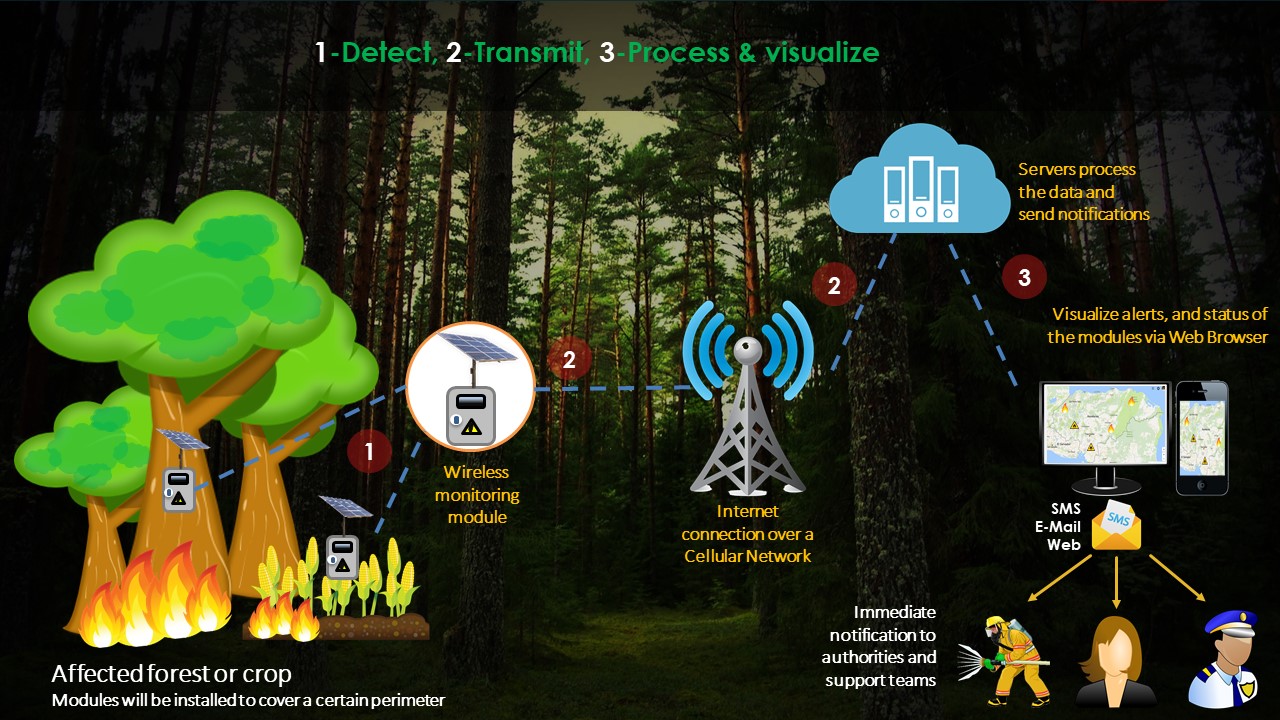
([source](http://internetoftrees.tech/howitworks.html))
https://www.youtube.com/watch?v=jhHaCx1LHa8
Internet of Trees provides a web-interface to monitor the status of all Fire Rangers [[4](http://internetoftrees.tech/howitworks.html)].
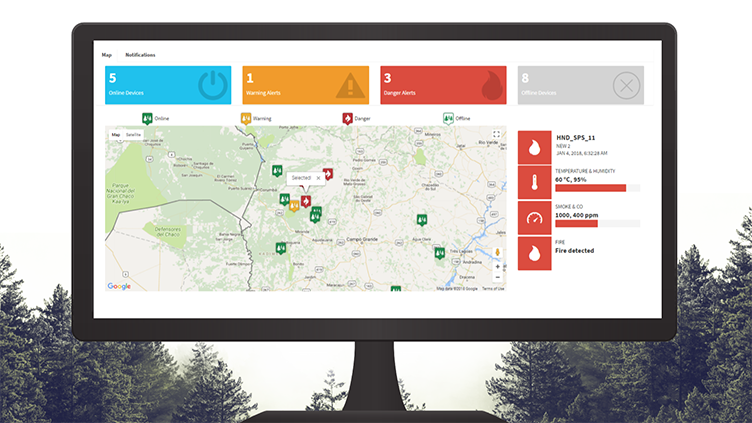
([source](https://electronics360.globalspec.com/article/11399/internet-of-trees-early-detection-of-forest-fires))
The data (about air quality and CO2 levels) provided by Internet of Trees also allow forest owners to manage their forest better.
Internet of Trees uses [LPWAN](https://en.wikipedia.org/wiki/LPWAN) (**Low Power Wide Area Network**; modern wireless communication technology) which meet the requirements of IoT-applications (long range, low data rate, low energy consumption, and cost effectiveness). Traditional communication standards (like Bluetooth or 2G, 3G, 4G) are either don’t allow long range transmission or consume too much energy [[2](https://hal.archives-ouvertes.fr/hal-01670379/), [[4](http://internetoftrees.tech/howitworks.html)]].
LPWAN
> provides long-range communication up to 10–40 km in rural zones and 1–5 km in urban zones. In addition, it is highly energy efficient (i.e. 10+ years of battery lifetime) and inexpensive, with the cost of a radio chipset being less than 2€ and an operating cost of 1€ per device per year.
... In summary, LPWAN is highly suitable for IoT applications that only need to transmit tiny amounts of data in long range
[source](https://hal.archives-ouvertes.fr/hal-01670379/)
The idea of Internet of Trees was inspired by a dangerous event happened in the life of its CEO (Goering Coffey) who almost lost his house because of forest fire. Being an engineer, he brought together a team of 5 professionals in the area of project management, software development, and telecommunication [[3]](http://internetoftrees.tech/about.html).
https://www.youtube.com/watch?v=0spYAtRxiGg
All images (without the license specified)/videos are used under the doctrine known in USA as "Fair Use" (similar doctrines are used in other countries). For more information visit the [US Gov website](https://www.copyright.gov/fls/fl102.html)
## References:
1. [Jane K. Hart and Kirk Martinez. Environmental Sensor Networks:A revolution in the earth system science?, 2006.](https://www.semanticscholar.org/paper/Environmental-Sensor-Networks%3AA-revolution-in-the-Hart-Martinez/2c2a6ed5b7c792c8a53fd3fc7e437371fe8a0128)
2. [Kais Mekki, Eddy Bajic, Frédéric Chaxel, Fernand Meyer. A comparative study of LPWAN technologies for large-scale IoT deployment. ICT Express, Elsevier, 2019, 5 (1), pp.1-7.](https://hal.archives-ouvertes.fr/hal-01670379/)
3. http://internetoftrees.tech/about.html
4. http://internetoftrees.tech/howitworks.html
5. https://www.ctif.org/world-fire-statistics
6. [Latest Forest Fires in California Highlight Need for Better and Earlier Detection Systems](https://medium.com/@internetoftrees/latest-forest-fires-in-california-highlight-need-for-better-and-earlier-detection-systems-93ba0caf2303)
## Other posts of this series
[Scientific innovations for human problems. Introduction](https://steemit.com/science/@alexbiojs/scientific-innovations-for-human-problems-introduction)
[Scientific innovations for human problems [Energy Supply]. SolarReserve (mirrors + molten salt) (or 75, 000 homes powered with solar energy, 24/7)](https://steemit.com/science/@alexbiojs/scientific-innovations-for-human-problems-energy-supply-solarreserve-mirrors-molten-salt-or-75-000-homes-powered-with-solar)
[Scientific innovations for human problems [Safety devices]. Aircraft ballistic parachutes](https://steemit.com/science/@alexbiojs/scientific-innovations-for-human-problems-safety-devices-aircraft-ballistic-parachutes-or-why-it-would-be-better-if-they-spent)
[Scientific innovations for human problems [Wastewater treatment]. Organica. Beautiful wastewater treatment revolution](https://steemit.com/science/@alexbiojs/scientific-innovations-for-human-problems-wastewater-treatment-organica-beautiful-wastewater-treatment-revolution) hiveblocks
hiveblocks